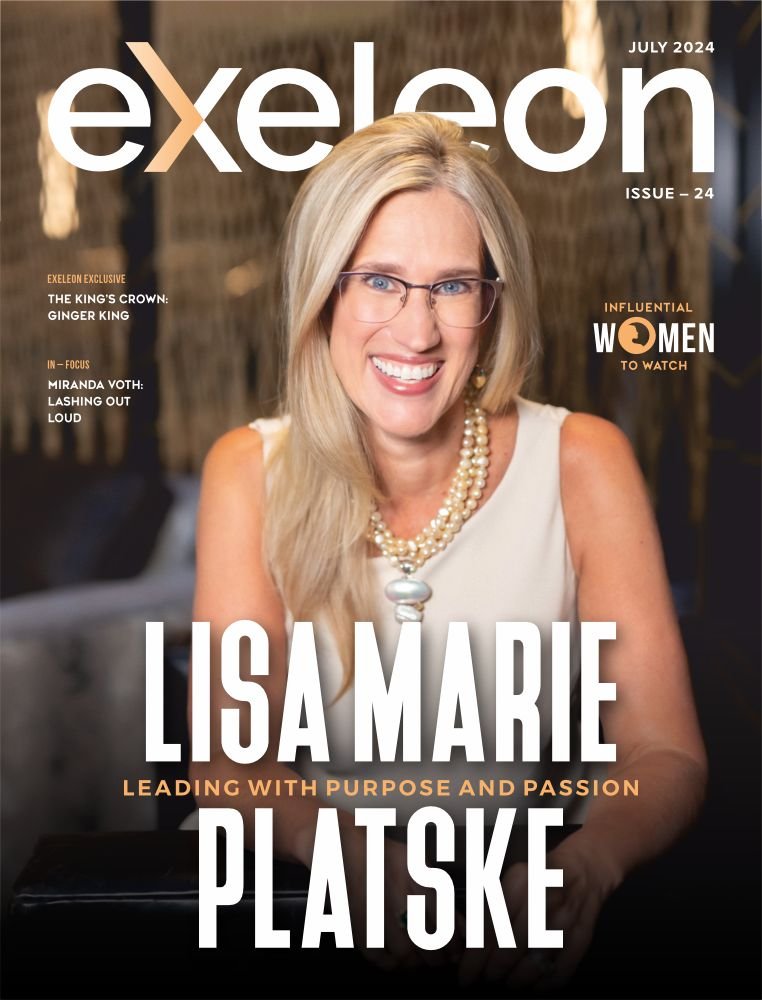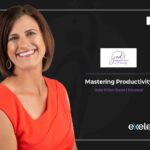
This interview with Morgan McCarver is part of Exeleon Magazine’s Transformational Women Leaders to Follow issue. Moreover, the issue is included in our Women History Month Celebration. Click here to read more stories and interviews of women leaders.
What according to you makes one transformational? How do you integrate the same thought into your leadership?
I believe being transformational is really a two-sided question. Firstly, if you are transformational, then you have gone through a transformation yourself.
Secondly, to be transformational means to be an integral catalyst for encouraging transformation in others. Undergoing scoliosis spinal fusion surgery as a young teenager was my biggest transformational experience. That experience ultimately led me to discovering my passion for ceramics, which has taken me on this journey for the rest of my life.
Physically, I was transformed to have a rigid posture for the rest of my life, but mentally, I also became closed off and very introverted. This doesn’t sound like the origin story of a leader, but after a decade of seeing the shy and timid individual I had become, I was able to recognize the beauty in my story and finally feel comfortable sharing it.
This second transformation allowed me to come out of my shell and sing the praises of beauty through my pain. I was able to see how my trauma was a necessity for my testimony. Now, I can’t help but share my story with others in the hopes of helping them too. My goal through my art, book, and experiences is that I can be that integral catalyst for encouraging transformation in others.
I want to encourage people to discover their own creativity and to see the goodness in their own lives. This is how I try to lead—by encouraging those around me to recognize their creativity and find joy in the talents and passions that God has given them.
Could you share the journey that led you to become both a ceramist and a stitchery artist?
I’ve always looked for a creative outlet. When I was little, both of my parents worked, so my grandmother kept me. She would make homemade play dough on the stove and let me help her color it with food coloring. Then we’d sit and play for hours. I say that’s my earliest start with a clay-like medium. Both of my grandmothers also taught me to sew by hand and machine as well.
As I got older, I was involved in competitive dance. Dance was my identity, my friend group, my exercise, and my creative passion. It was all taken away from me though when I had scoliosis spinal fusion surgery at age 14. I had 3 s-curves in my spine that were only getting worse by degrees over time. Even though I wore a corrective back brace for 3 years, my spine was still getting worse. It was also rotating, affecting my organs. My lung capacity was the first thing to be inhibited, and the doctors knew my spine would only continue to get worse. I was praying that I wouldn’t have to have the surgery, but that wasn’t the story God had for me.
After the surgery where the doctors fused my entire spine with 2 titanium rods and 18 screws, I had a yearlong recovery process where I wasn’t supposed to bend, twist, pick up anything over 10 pounds, jump, and especially dance.
This year was such a challenge for me because I was physically and mentally changed, and my creative outlet was forbidden. I ended up taking a summer pottery class and immediately fell in love. I found freedom in my relationship with clay. It had the flexibility I could no longer find in my own body. I kept taking class after class and eventually went to college for ceramics. I have my degree from South Carolina School of the Arts, Anderson University, SC.
Upon graduation I officially started my own business Morgan McCarver Porcelain. For over a decade I didn’t talk about my scoliosis experience. I didn’t want to share my story. I wanted to blend in as “normal.” I started to realize though that God gave me this story for a reason.
Looking back on that experience over 13 years later, I’m able to see that God allowed me to have the surgery so that I could discover my love for pottery. My passion for ceramics has taken me farther than dance ever could have. At the time, I thought dance was the best thing for me, but God had something so much better for me. What felt like the worst thing to happen to me ended up being my turning point. Through ceramics I’ve been able to share my story and the amazing work that God has done in my life, and now I have written a book called “God the Artist” that unpacks the creativity of God as well as gives an inspirational account of pottery and how it is referenced in the Bible.
Can you describe the primary themes and inspirations behind your ceramic and stitchery work?
Like the female mentors in my life, native wildflowers have always been near to me; I just have to seek them out. Women have historically been compared to delicate flowers; I reinterpret that symbolism by allowing the porcelain wildflower imagery to represent a woman’s inner strength. I apply my drawings as transfers similar to a seamstress overlaying patterns and designs on a dress form. Individuality within the identical is found through surface design.
Hexagons embody the human desire to control organic. The hexagon verges on circular, but still upholds rigid angles. Similarly, the organic female silhouette adapts to cultural beauty standards through rigid stays and corsetry.
My experiences with scoliosis corrective back bracing and surgery allow me to empathize with my corset-wearing ancestors. Metal rods and boning are ingredients for both corsetry and scoliosis surgery. My back brace was painful but designed to correct my form. The surgery straightened my spine permanently with metal screws and rods.
Similarly, the Victorian corsetry was designed to “perfect” the female body through constricting boning. My “S” curve needed to be straightened, while Victorian women used their corsets to enhance their curves.
Inner strength has a different meaning for everyone. For me, it’s learning from my female ancestors and mentors, relying on my Faith, and building from my own experiences.
My work reflects the delicacy that is associated with women, porcelain, and flowers, but it also reveals the natural strengths of these three as well.
What challenges do you face in your creative process, and how do you overcome them?
Probably the biggest challenge I face in the studio is my physical limitations. Moving boxes of pottery around get heavy and taxing. I’m trying to be better at listening to those signals from my body instead of ignoring them and pushing through the pain—that’s how I’ve ended up breaking toes, developing tendonitis, and messing up my knee. It can be a fight against yourself to stop doing what you love and take a break, but it’s better in the long run to preserve your body for future decades of art making.
Also, there are many hazards in the ceramic studio; for example, breathing in clay dust can lead to silicosis, and most dry glaze materials should not be inhaled. Several ingredients can cause cancer. The kiln fumes are also harmful…all that to say it’s important I take the proper precautions to protect myself from the dangerous side of my craft.
Other challenges include being willing to take the risk and deciding on which risks taking. There are a lot of opportunities in the art world, but they all won’t be a good fit, so doing research to decide how beneficial something might be is always a good idea.
My advice is that if you’ve researched and believe you can pull it off, then go for it! Why not apply? That mentality has given me some amazing experiences. Of course I get rejected too, but I don’t let myself focus on that. I am always looking to what is ahead and planning for the next application.
How do you engage with your audience and the wider community through your art?
Participating in shows, residencies, and festivals is a great way for the community to meet me, the artist, instead of just seeing my art. I love these events because they allow me to get feedback from the community on my work as well.
When it is not show season, I have work in about 10 galleries and shops in the Carolinas and Tennessee, so my work is always available for purchase. Recently I’ve been doing book signings with the release of my new book, “God the Artist: Revealing God’s Creative Side Through Pottery.” These signings, and the book in general, have allowed me to connect with my audience on a whole new and personal way, as well as broaden my community and reach a wider audience as well.
I also actively serve in my church and recently was able to offer wheel throwing classes for the middle and high school students. Being able to teach students who are the same age I was when I discovered pottery truly allowed me to come full circle and be able to give back. I was able to give these students an introductory experience to a creative process that could be as transformational for them as it was for me. It was an honor to be able to provide that experience for them and watch them connect with the clay and fall in love with ceramics like I did all those years ago.
How has your art evolved over time, and where do you see it heading in the future?
The beauty of life is that we’re always evolving, growing and changing, so naturally this is reflected in my art. Sometimes my work evolves from a customer feedback approach—changing a handle to better suit the customer for example. Sometimes my work evolves based on the statement I want to make.
My wildflower designs are a relatively new body of work for me, only a couple of years old. I say that wildflowers are my favorite flowers because they are such an unexpected surprise. I love seeing them on my drive through the mountains or on a walk. No one plants them or cultivates them. No gardener makes sure they have enough sunlight or water. Wildflowers look delicate but have an inner strength to them that is so beautiful. They grow for no one but God. They aren’t trying to please anyone. They simply grow in their own beauty whether anyone ever sees them or not. Some also have defense mechanisms too, for example thistles have thorns for protection. This commentary on the balance between visible delicate beauty and unexpected inner strength is really where my work is seated. In the same way, porcelain looks delicate – and is to some degree – but it is also beautifully strong. It has specific strengths that make it ideal for use in bathroom sinks and toilets. It is used in some bone transplants. It has also been used in elements on rocket ships. There is a hidden strength there that gets overlooked. Similarly with Victorian women, they were supposed to look and be beautiful, but they still had such intellect and hidden power.
As a female artist I relate to and draw from these examples. Because of my scoliosis surgery, I appear delicate. I am not as strong as most ceramic artists. Lifting a 50-pound box of clay is my limit. While physically I appear delicate, I too have a hidden strength that empowers me to make my art and write “God the Artist.” I’ve learned I can’t dwell on my limitations, rather I should focus on my strengths. My hope is that my work empowers and inspires others to recognize the beauty in their own lives and to find their balance between delicacy and strength.
Who’s to say how my art evolves in the future? The beauty of the present is not knowing and being allowed to discover the journey as I go. Right now, this is my art, and this is the message I’m designed to share, but I can’t wait to see how my work changes in the coming years and what statement I’ll be making then!
Are there any upcoming projects, exhibitions, or workshops that you’re excited about?
Always! I have a solo exhibition coming up in April that I’m preparing for right now. I’ll also begin hosting Christian small groups in my studio space for a weekly pottery lesson and study of “God the Artist.”
I’ve also been invited back to Edgewood Cottage for the third consecutive year as an Artist in Residence with the Blowing Rock Historical Society. This program is very unique in that artists are given a week to transform a historically preserved cottage into an art gallery. There are artist teams that rotate weekly throughout the summer, and this year I’ll be selling my ceramics in the Cottage May 27-June 2, 2024.
I’m always thinking and planning new projects, so follow me on social media to see what I’m up to. Of course, I’ll also be participating in shows and festivals again in the fall.
How can individuals and collectors best support your work?
Please visit my website www.MorganMcCarver.com. From there, you can shop for my ceramics on my Etsy and Faire sites, see a complete list of the shops and galleries that carry my work, sign up for my newsletter, connect with me on social media, see pictures of my work, and buy my book! I love connecting over art and creativity, so please don’t hesitate to reach out with questions, inquiries about custom orders, or just for art-related conversation!










